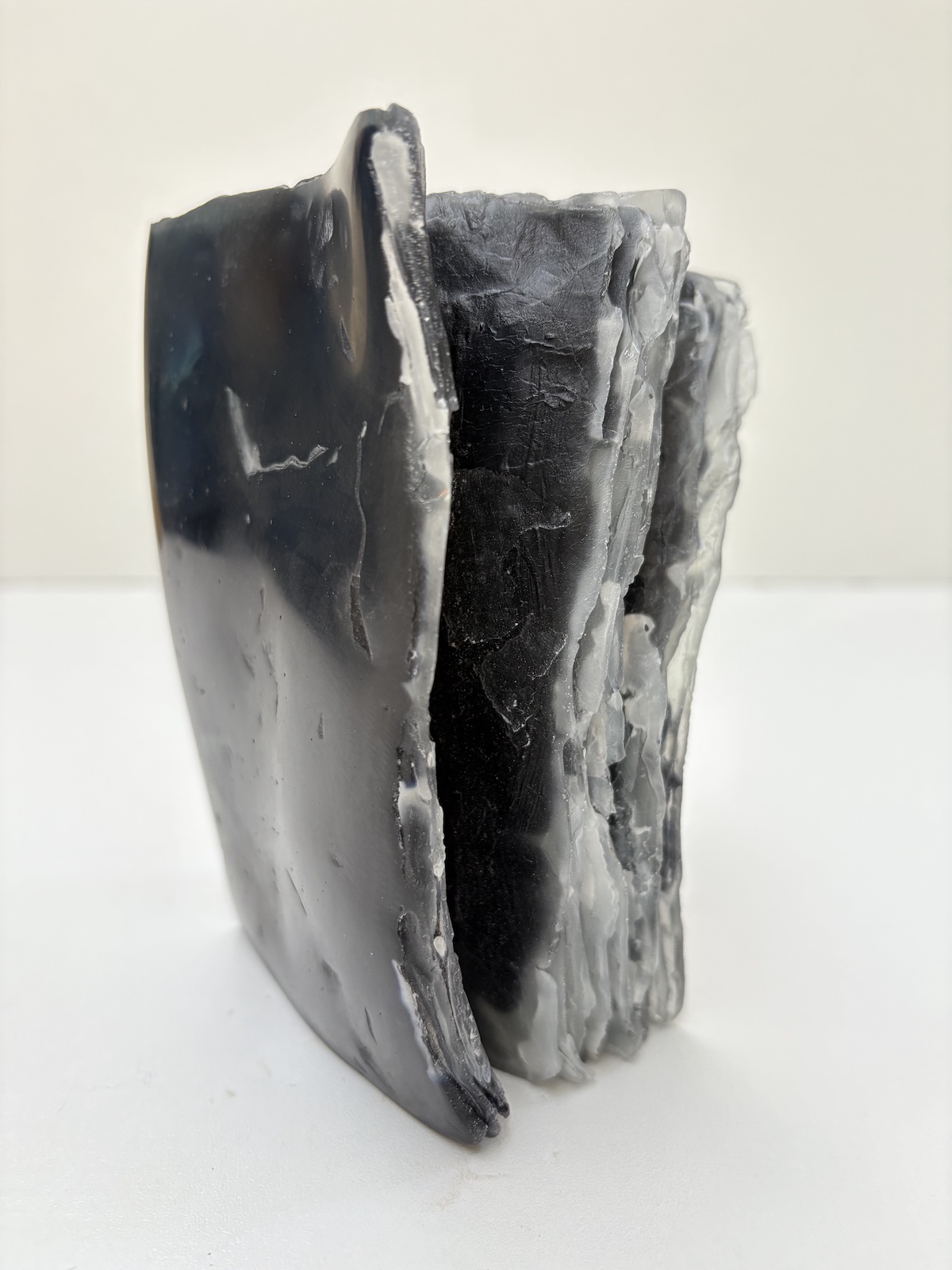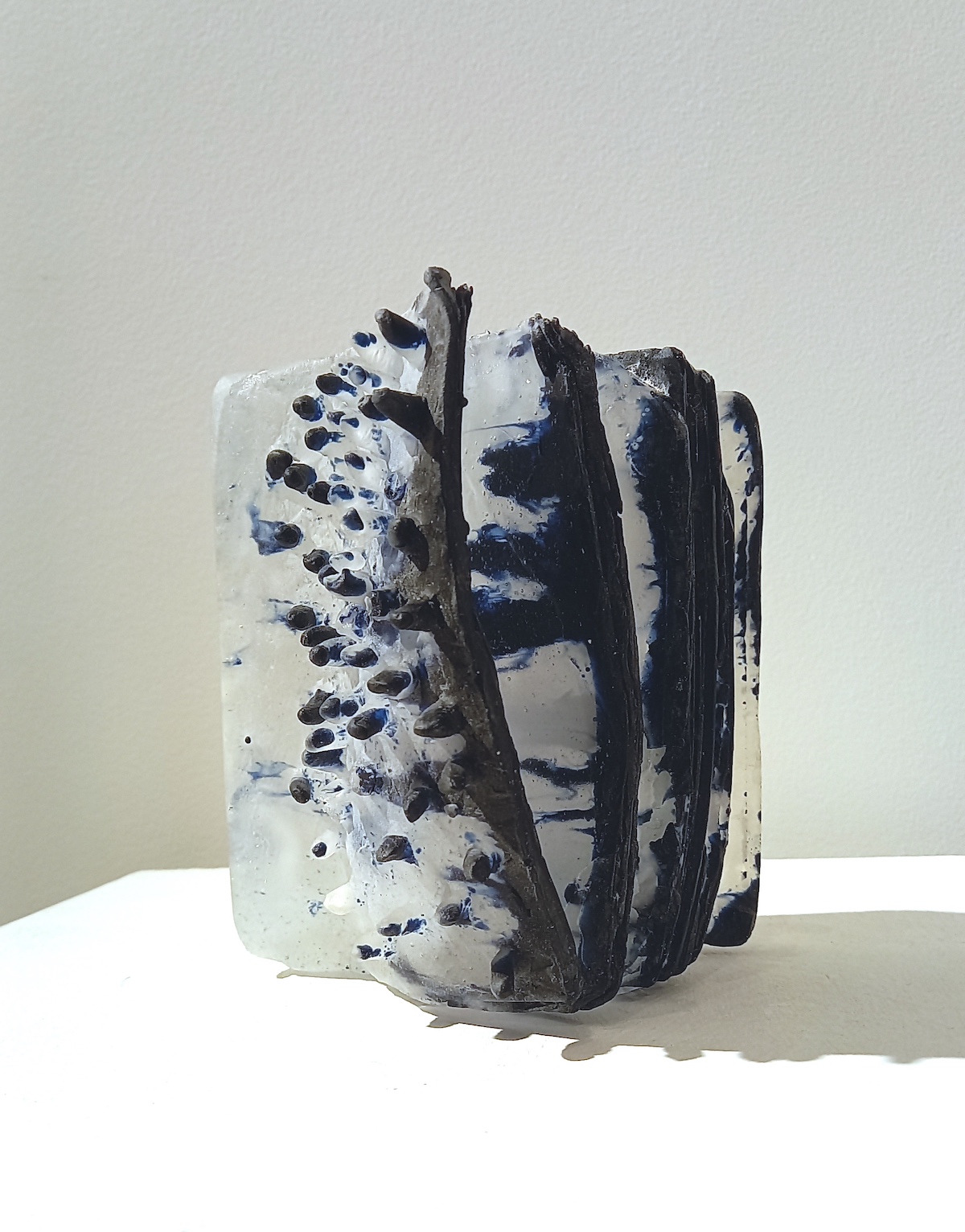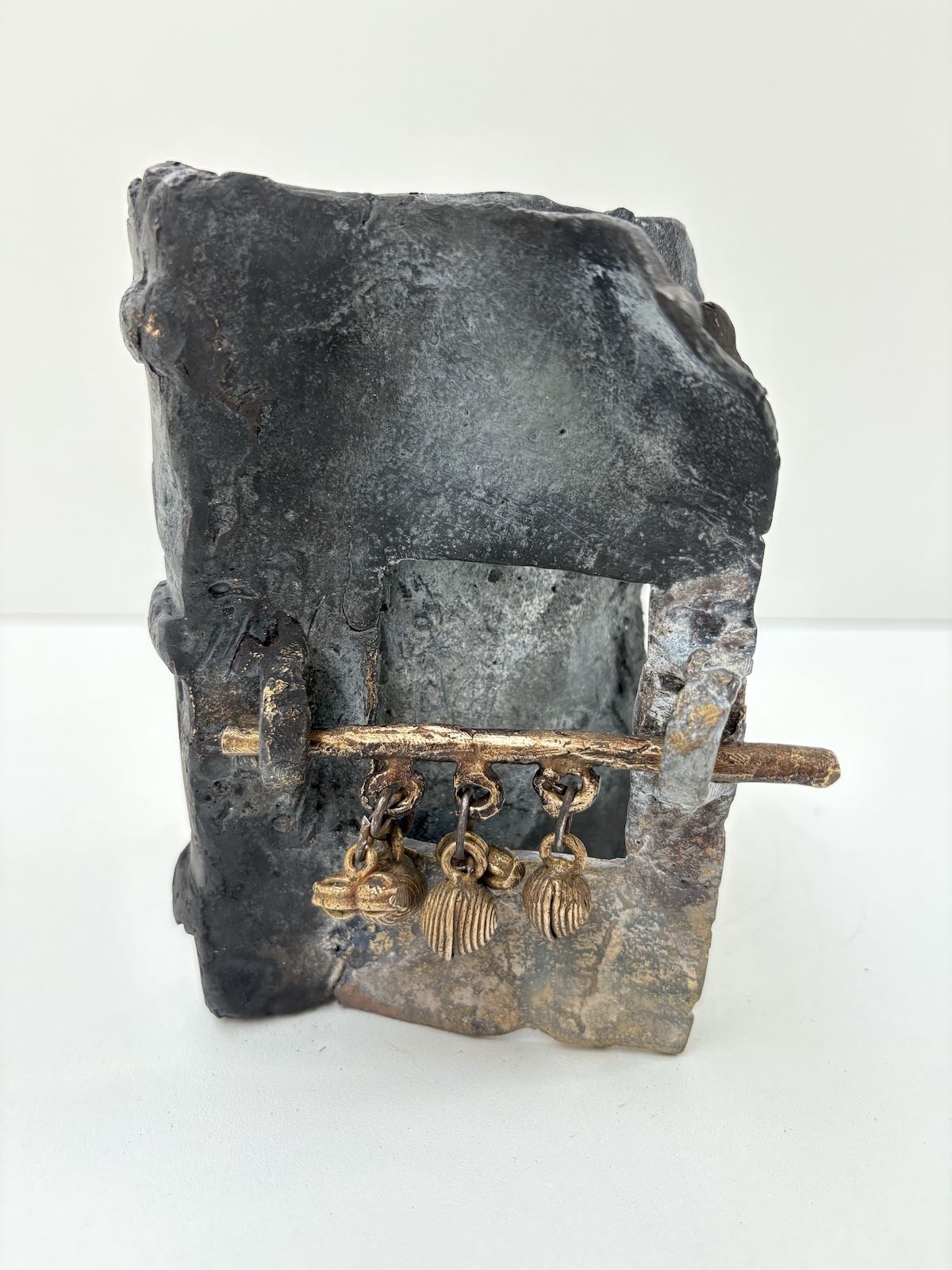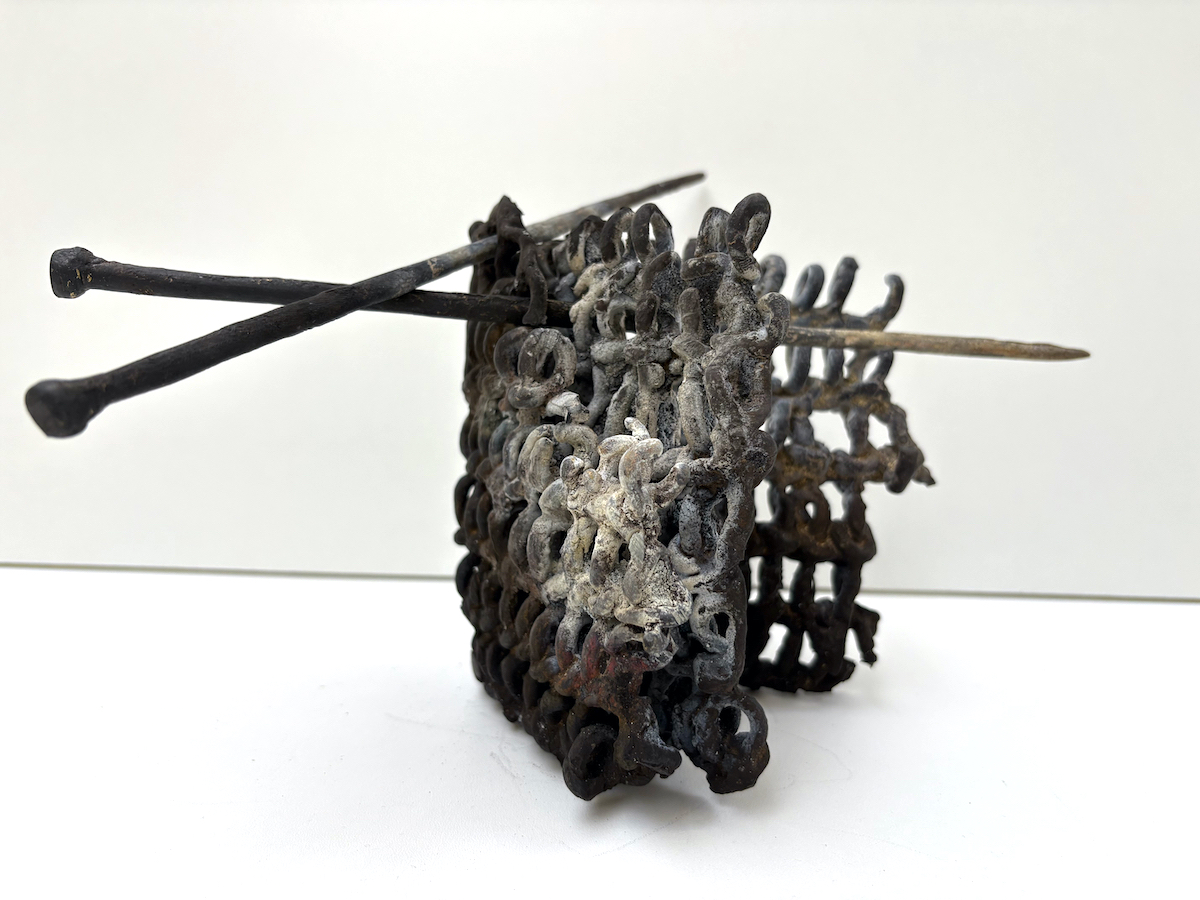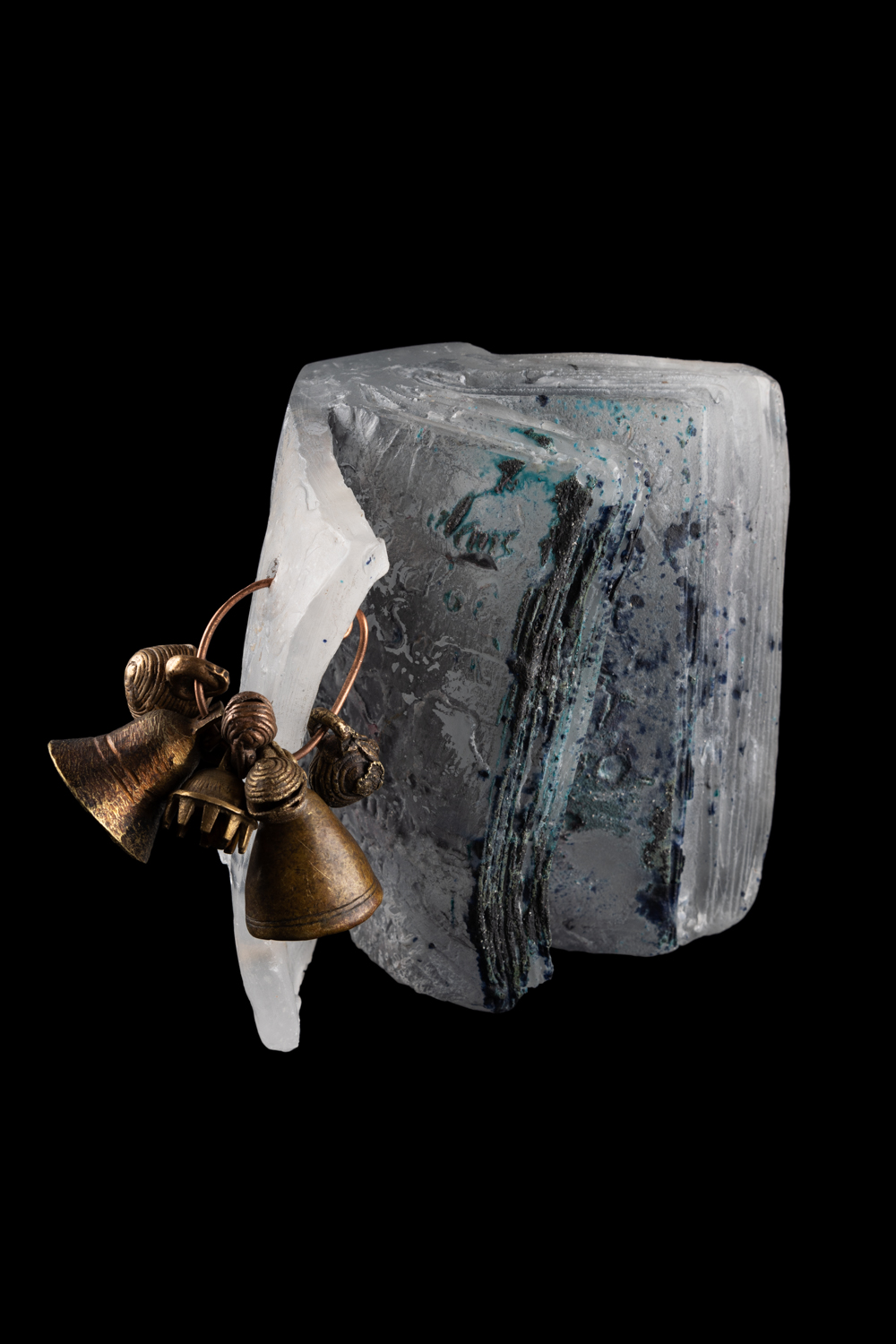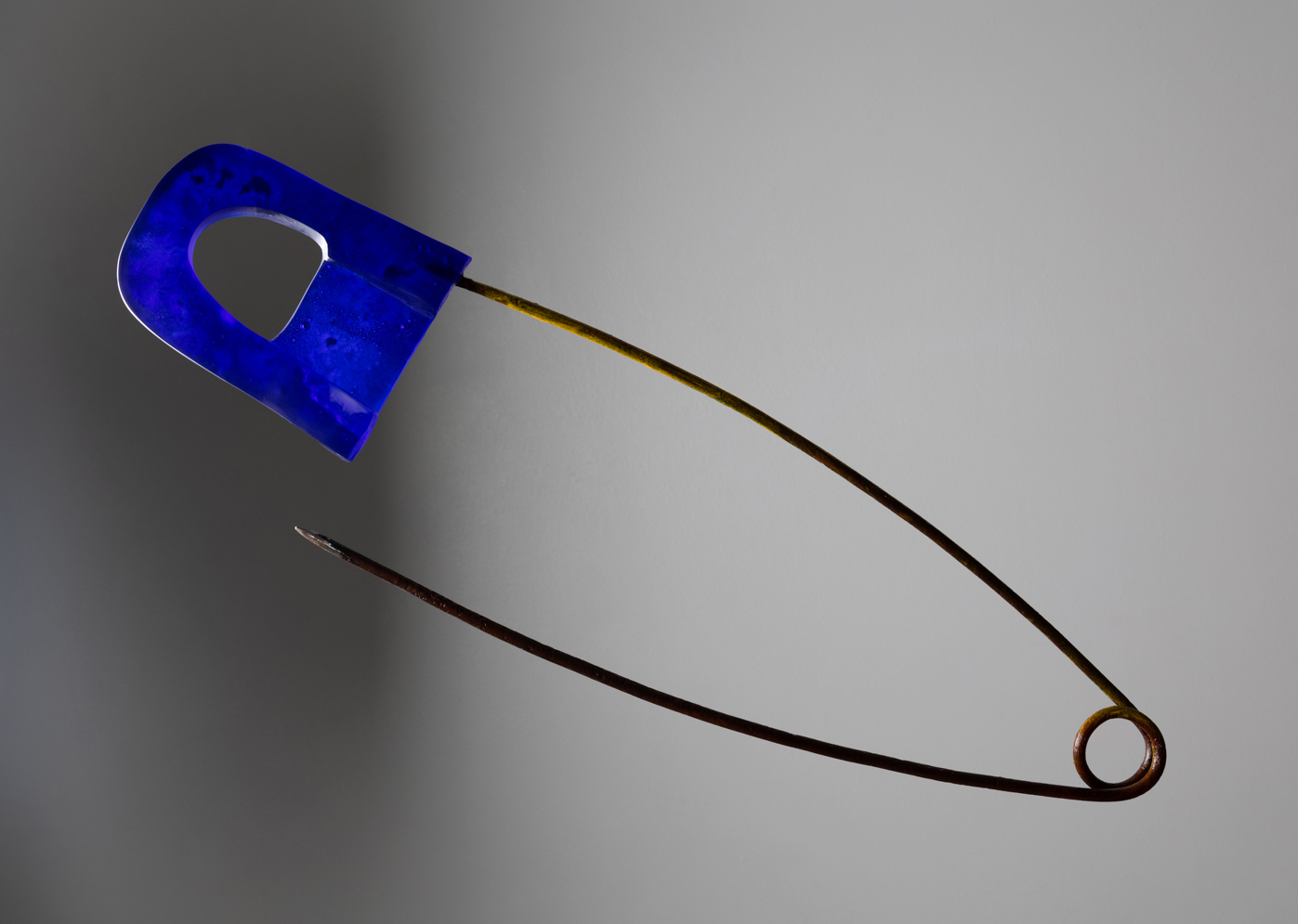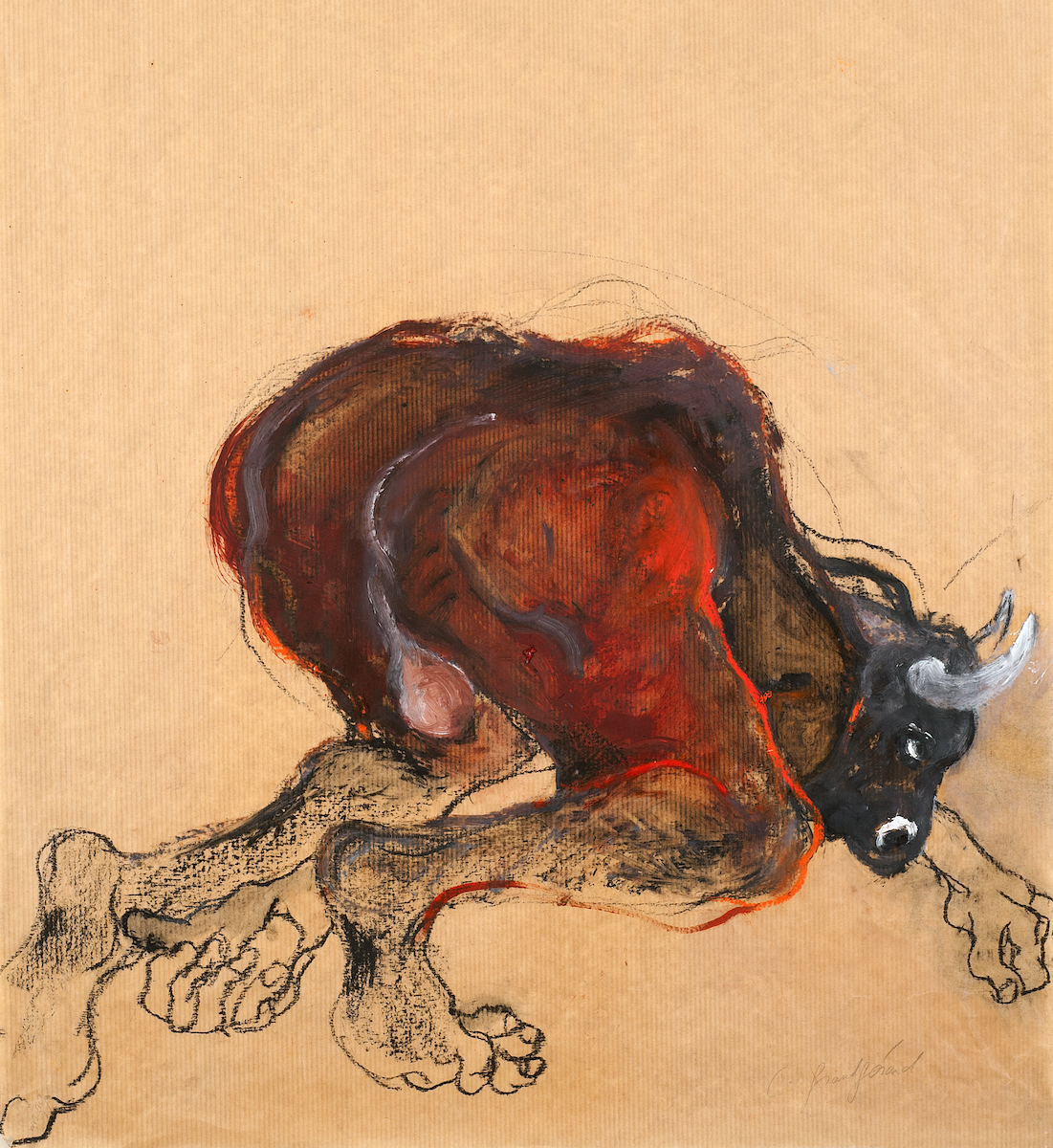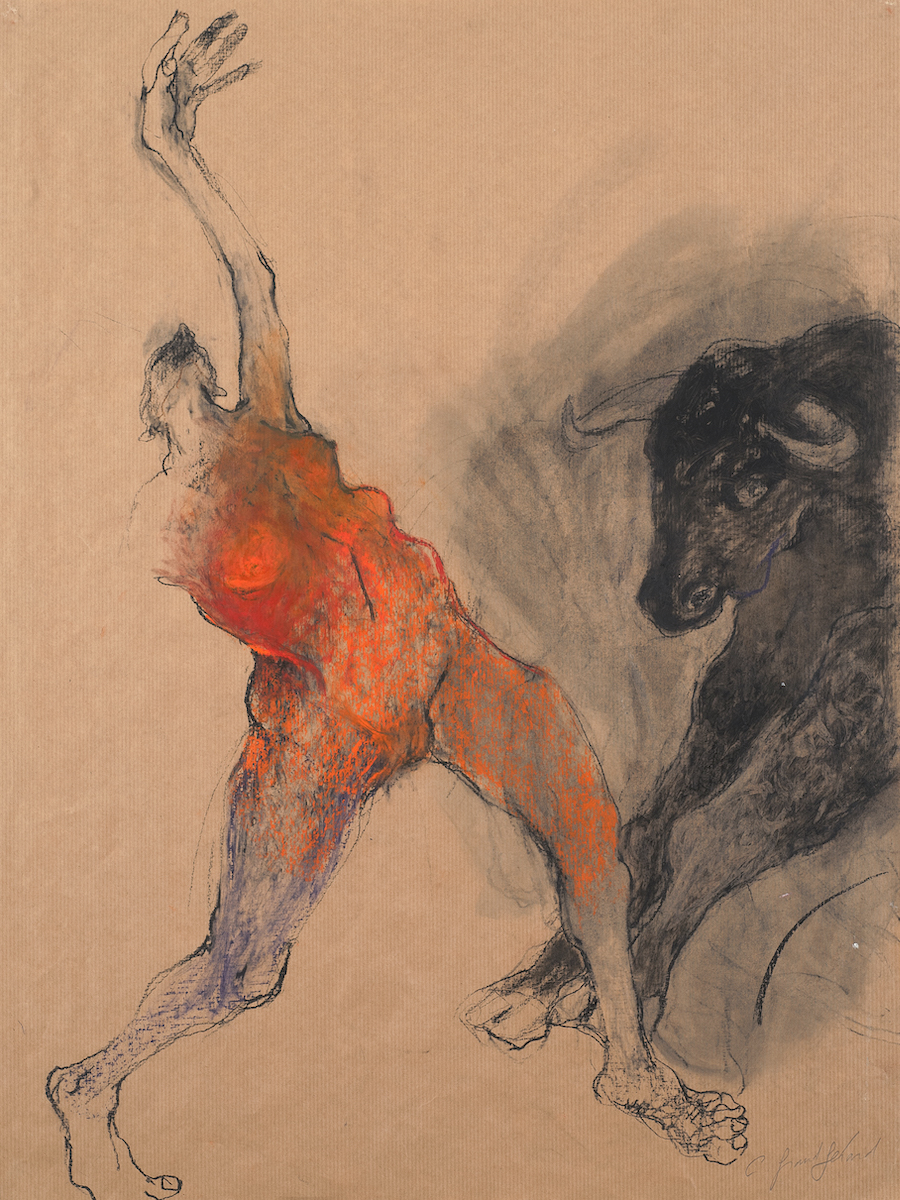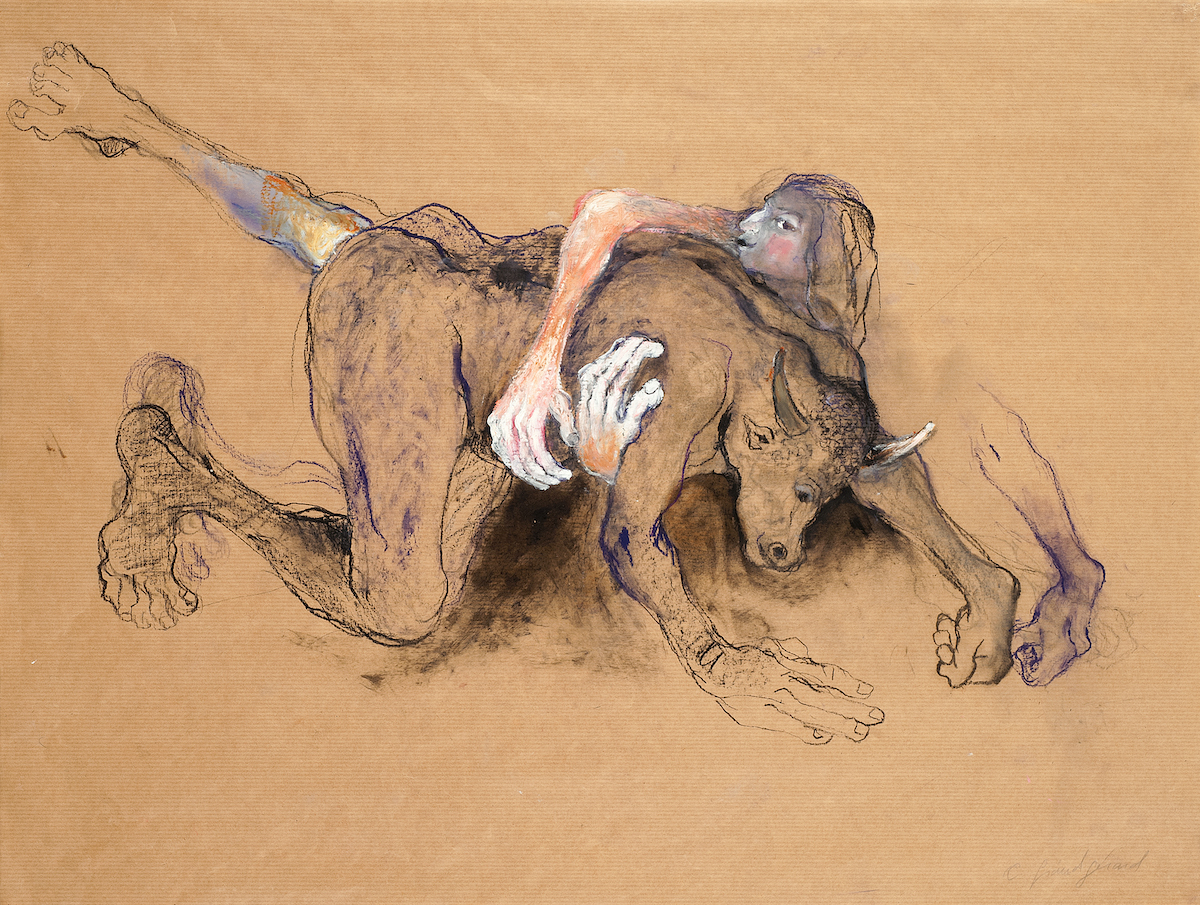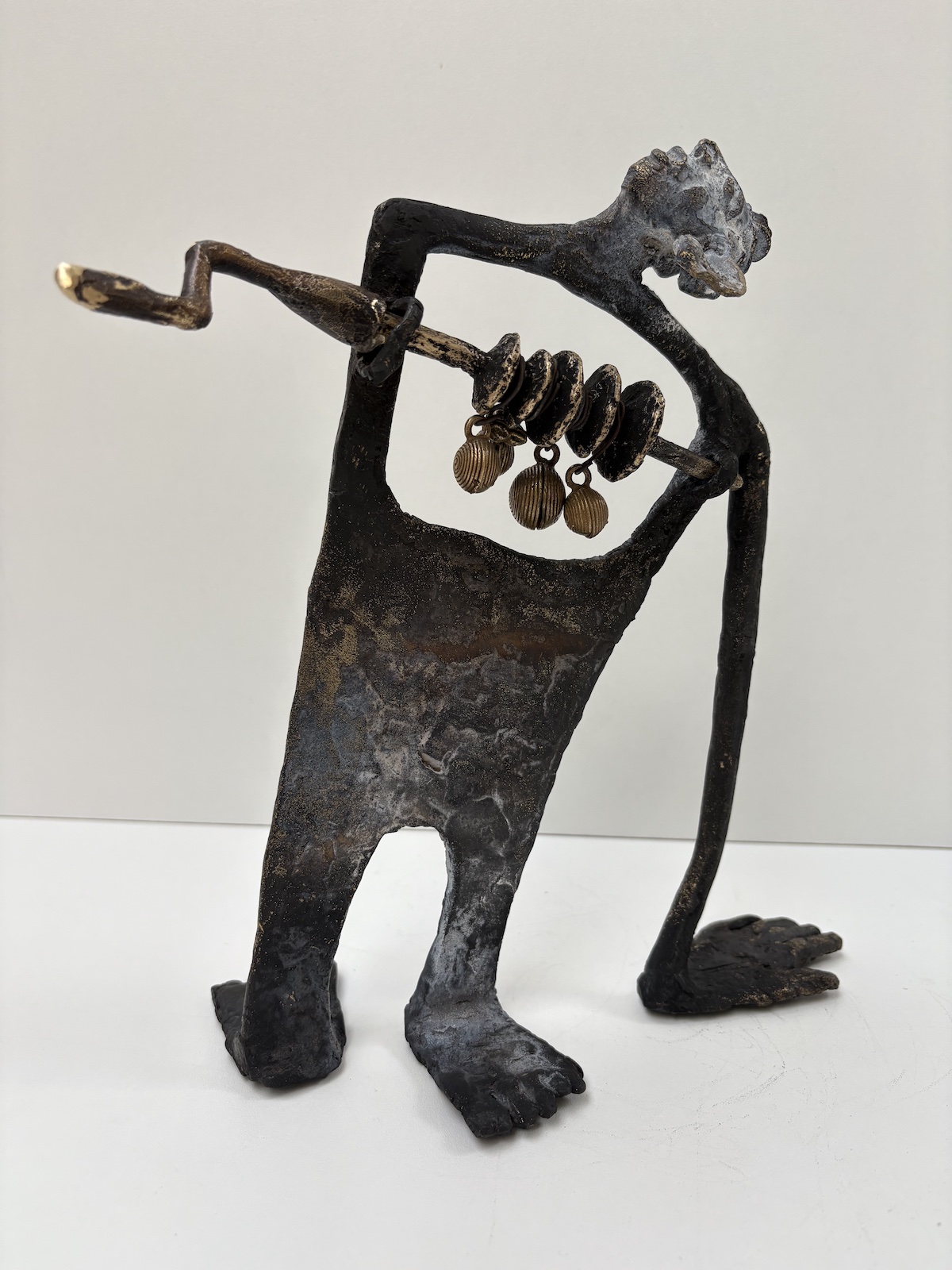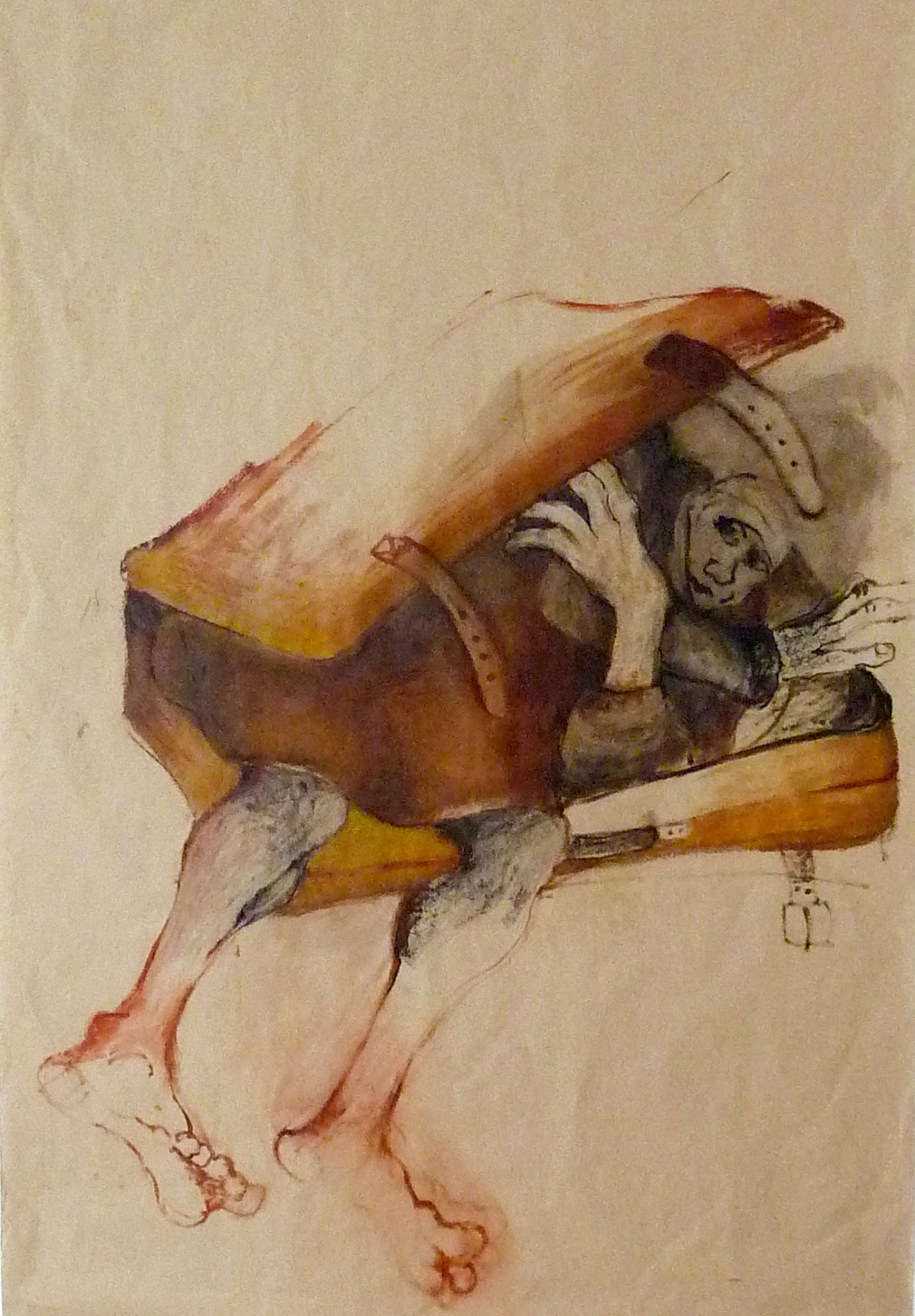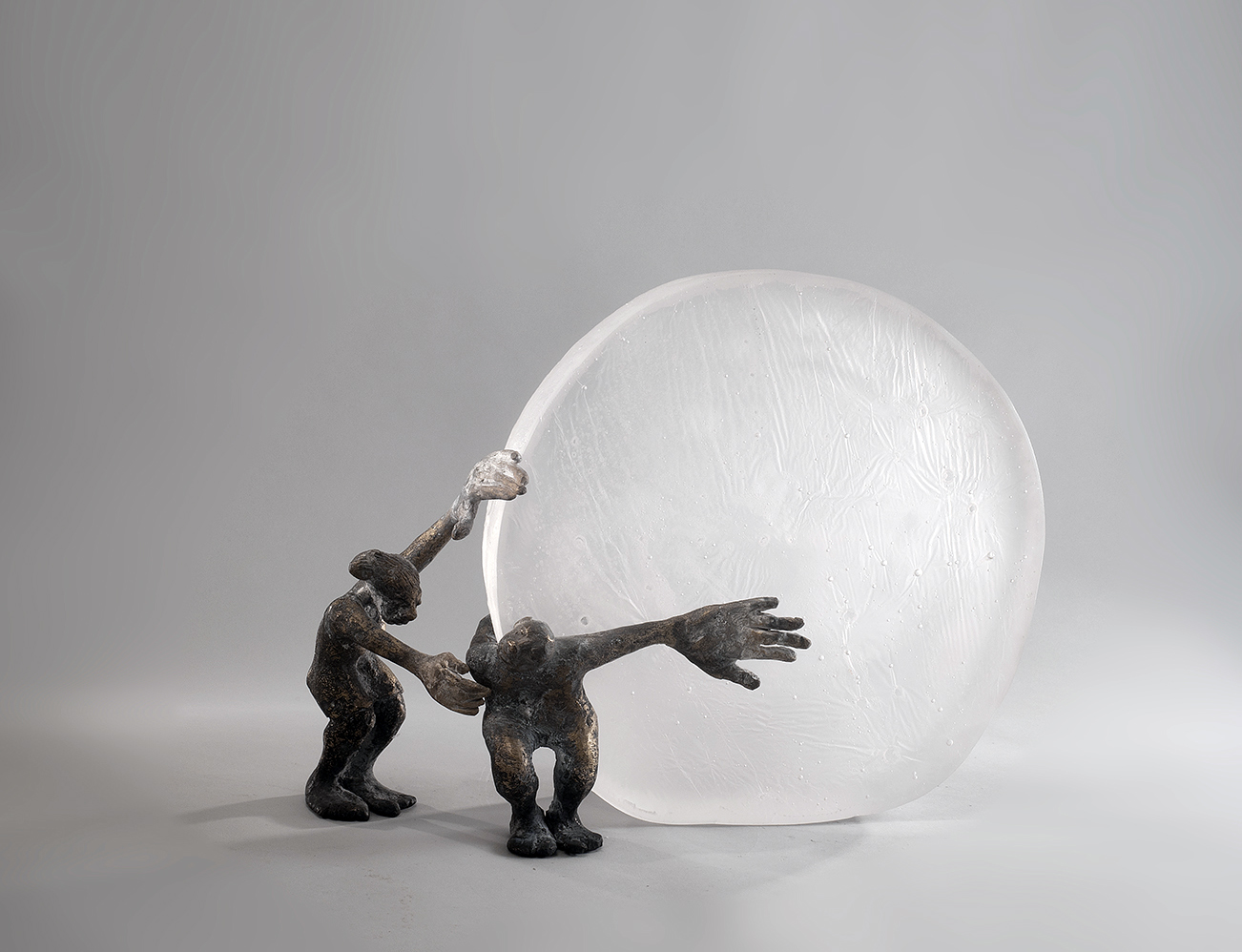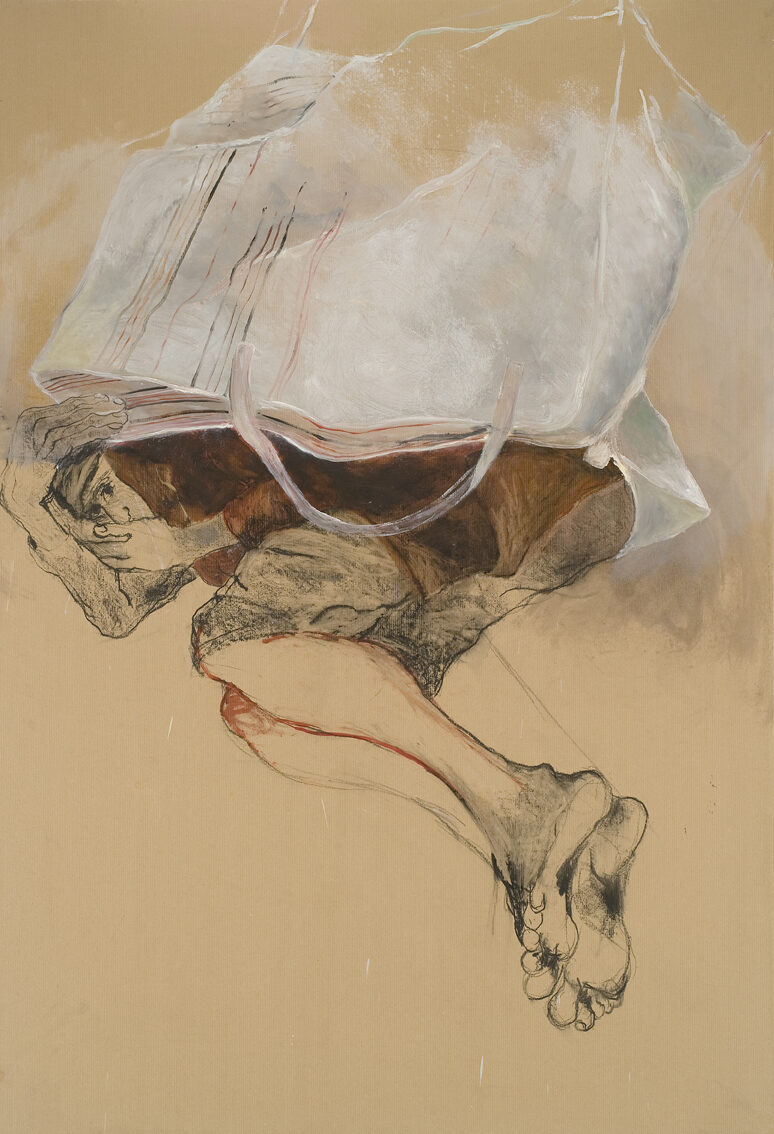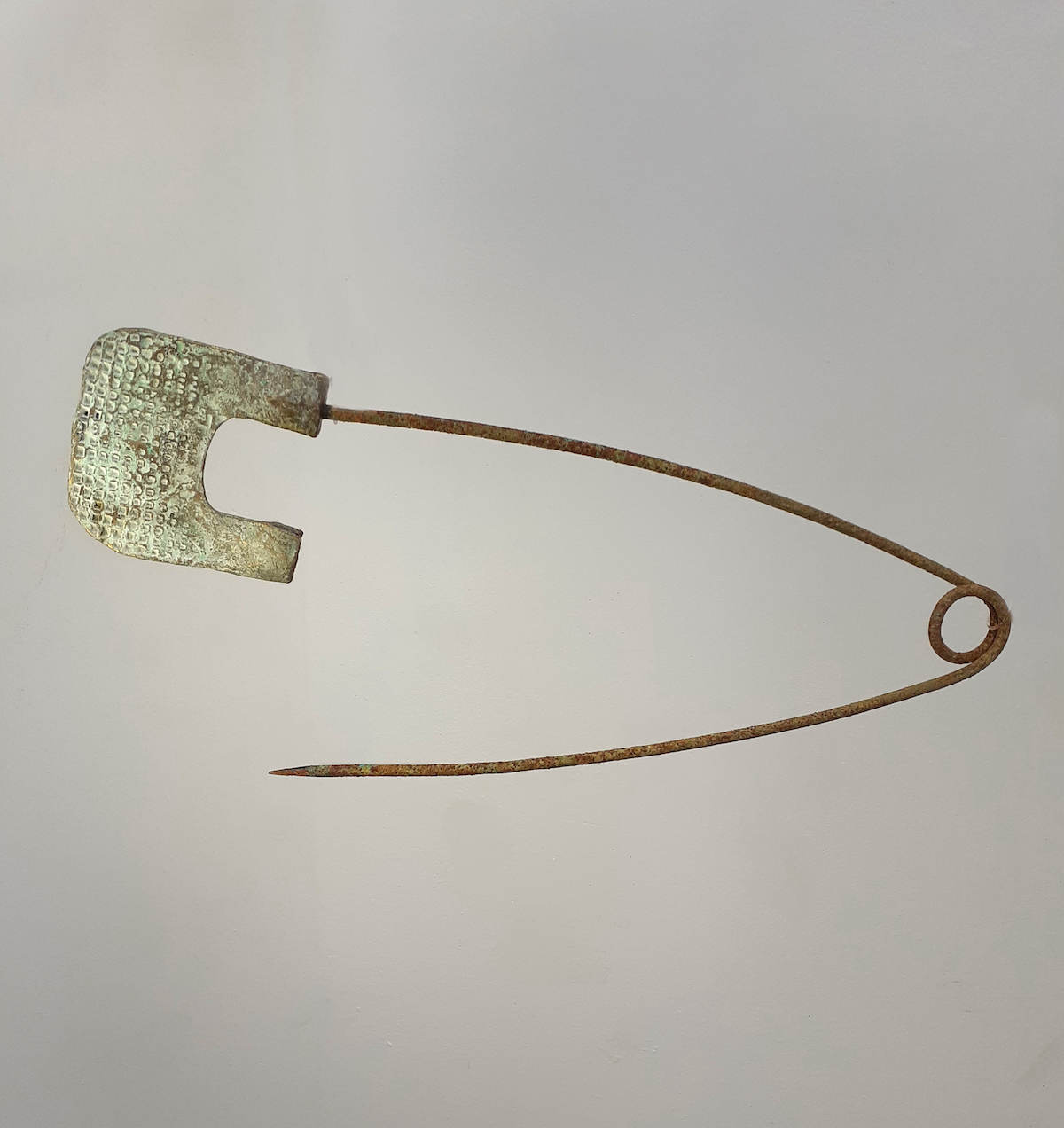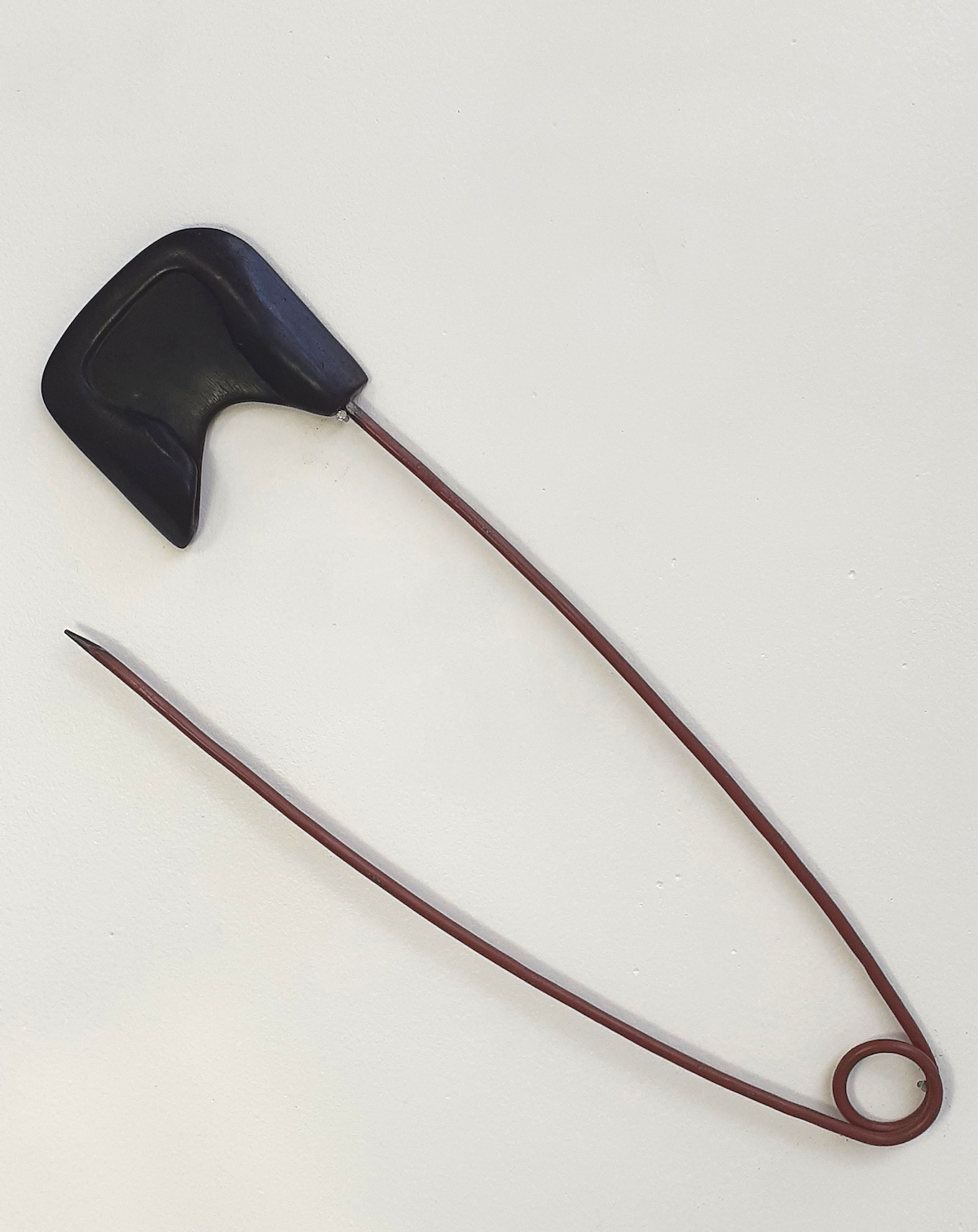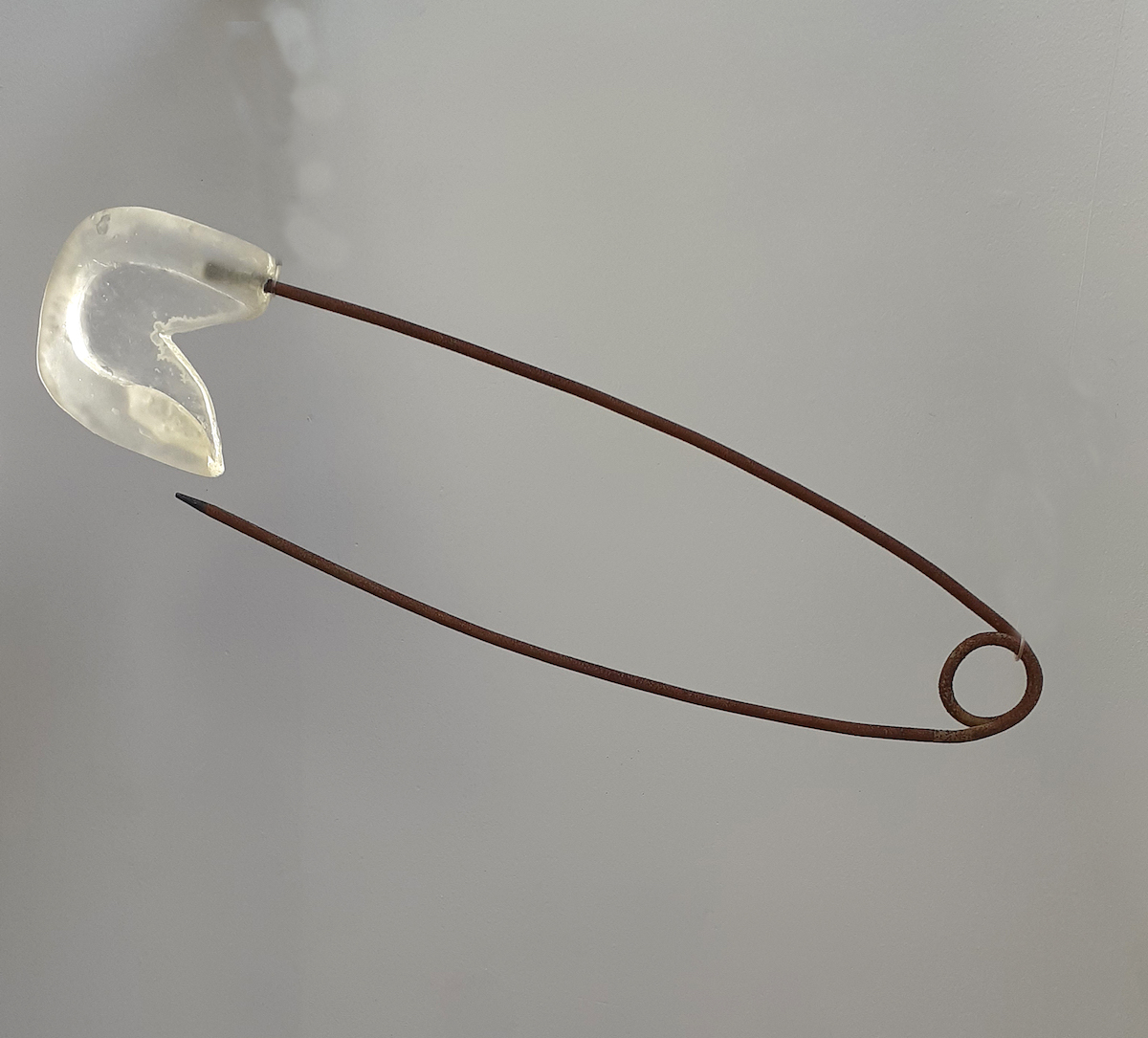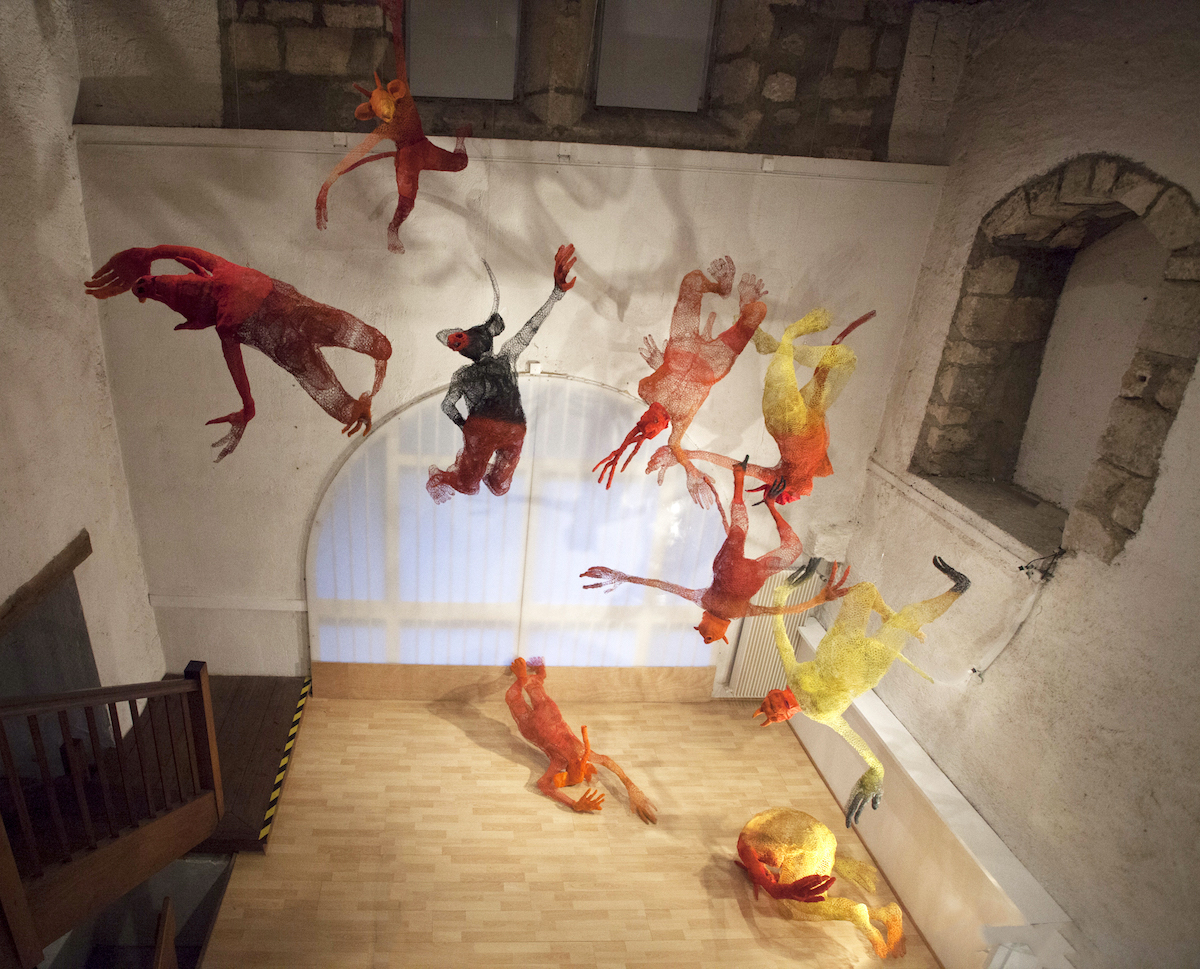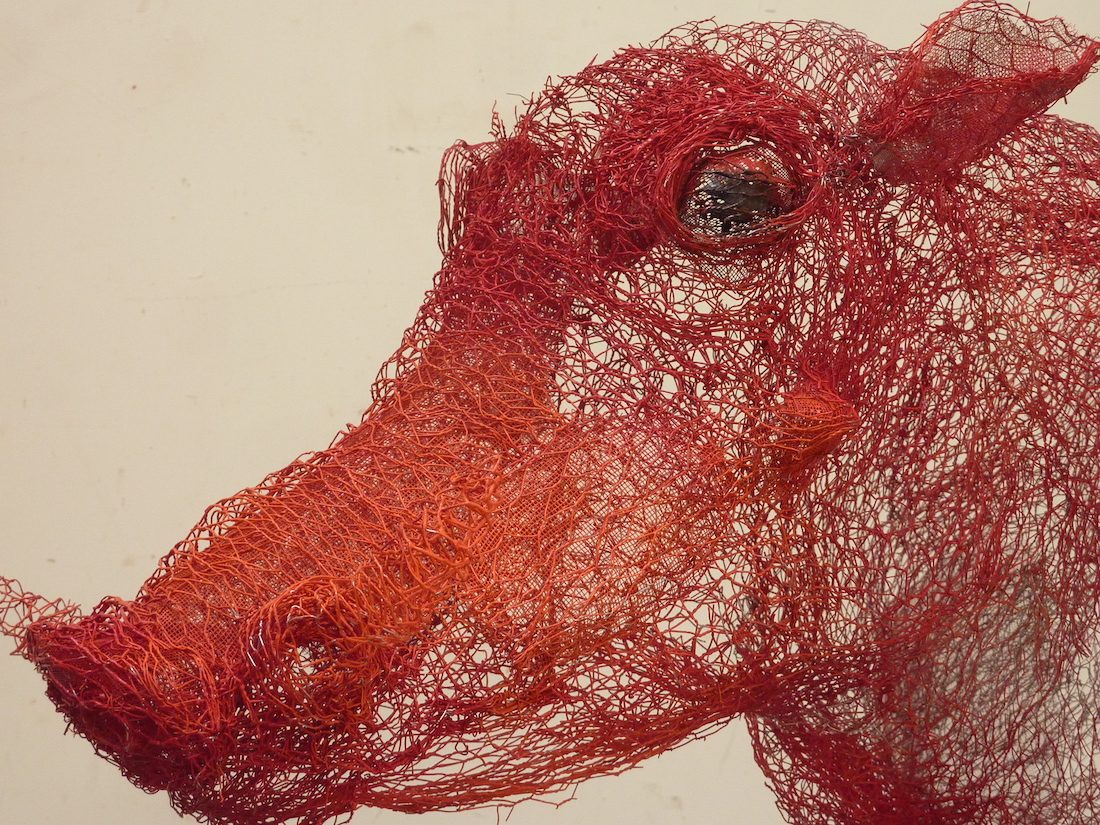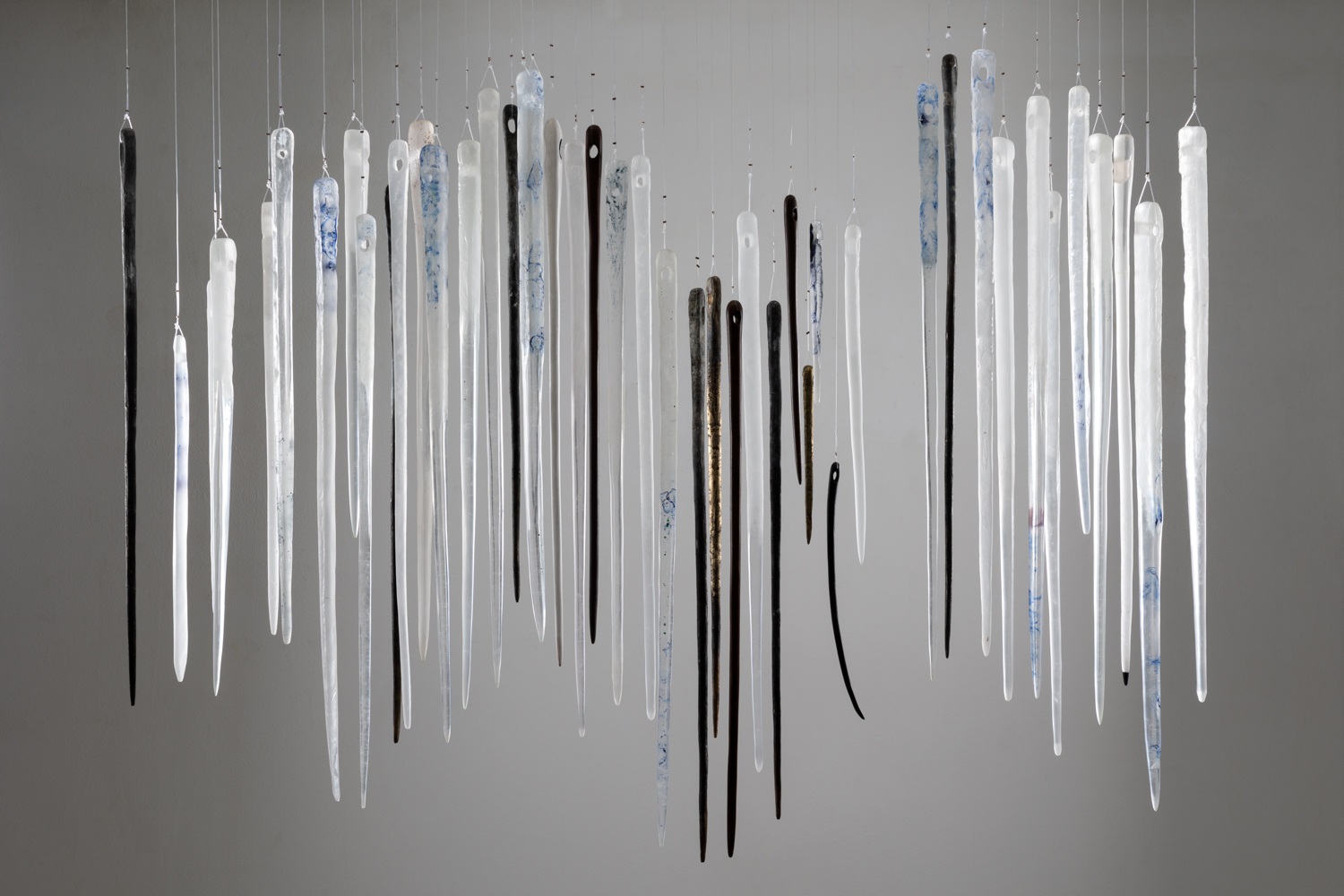Colette Grandgérard
artwork
recent artworks
Book Just a Shadow, 2025
Black crystal paste sculpture molded and polished
Height: 15 x 10 x 11 cm
One of a kind piece
Book Spicy pork 2, 2023
White and dark blue crystal paste sculpture molded and polished
13 H x 9,5 W x 12 cm D.
One of a kind
Book to unravel, 2025
Bronze sculpture in three parts: the book in sculpted mesh and two knitting needles.
Height: 15 x 13 x 32 cm.
One of a kind piece
TEXT
Biography
LIVES AND WORKS IN PARIS, FRANCE.
Initially a painter and illustrator, I made a shift at the turn of the 2000s by incorporating volume and space into my approach in two forms: installations and object sculptures.
These two forms mean that my exhibitions are hosted in a variety of different venues – cultural centres, abbeys, public gardens, streets (sculptures suspended between two buildings as part of Nuit Blanche Paris), barns… on the one hand, and galleries on the other.
Alongside my three-dimensional creations, I continue to pursue my initial two-dimensional approach by producing series of paintings on themes that may or may not be related to the installations.
Sculpture-objects in bronze and/or crystal paste.
These sculptures, created in both Benin and France, combine contrasting approaches to technical processes and, through them, ways of relating to the world.
My travels in West Africa, particularly in the voodoo country of Benin, combined with my dual training as an artist and sociologist, have nourished my approach for several decades.
The term ‘travel’ may seem inappropriate insofar as these are true immersions dedicated to creating bronze pieces in collaboration with traditional foundry workers.
During these long stays, I discovered other worldviews where the visible and invisible coexist, different language structures, other grammars, other customs and traditions, and I questioned our way of being, thinking and living.
The bronze sculptures were created in the forges of Abomey in collaboration with a foundryman, Eudes Hounton.
During my stays in Benin, I discovered the lost wax bronze technique, the fruit of an ancestral tradition. Originating in Ifé, it spread over the centuries to other kingdoms without undergoing any major changes.
I was immediately captivated by the raw, unpredictable nature of the process, due to the high pressure of the molten metal in the red clay mould. Accidents are part of the technique. For bronze smiths, they are fundamentally a manifestation of the wrath of Gou, the god of fire and forging, whose favours require offerings and strict adherence to rules.
In African society, bronze work is not simply a matter of the craftsman’s skill and expertise; it also involves the invisible world.
This is why the manufacturing process for a piece involves preliminary rituals. On Tuesday, the day dedicated to the god, the smelter does not handle the fire; on the eve of casting, all sexual relations are forbidden; the inauguration of a new bellows, the lung of the forge, requires the sacrifice of chickens or goats, whose blood is spilled and fed to Gou. If the rituals are transgressed, beware of failures.
Imbued with the spirit of the gods, the technique is also rooted in a strong relationship with nature. Each stage is steeped in it: beeswax as the basic material for making the mould, red earth for making the moulds, wood fire for firing them, charcoal for casting, and finally various leaves for the patinas…(…)
When creating a bronze piece, a vision of man and his relationship with the world is at work. For the ‘blacksmith’ of Abomey, his skill rubs shoulders with divine intervention and the forces of nature; he does not claim to be the sole master of a highly empirical process. Such a lesson in humility has its downside: failures and successes, being the expression of forces that are partly beyond human control, cannot be subject to critical questioning.
Here are a few guiding principles to illustrate my approach to my work, building bridges between cultures in a dialogue between a plurality of materials:
Books (made of bronze or crystal paste) are objects that we hold in our hands, caress, leaf through; they open and close, tear, and become dog-eared. We slip improvised bookmarks into them, metro tickets, postcards, cinema and museum tickets… other sheets that are added to the pages, in complete freedom.
Signs and words have been deposited on their skin for centuries… a parenthesis in history? Time leaves its mark on them; stains, erasures, creases are all traces of the readers who came before. Sometimes they lose their ink, in drops, in waves, liquids migrating to other media, other bodies.
They have their specific territories. Libraries and bookshops have been invented for them. However, they sometimes opt for other territories, places of disorder… such as littering the floor in unstable piles, in generous cascades, or serving as stepping stones or wedges.
The crystal paste or raku sculpture work is carried out by the artist in Montreuil at Paul Fleury’s studio.
The bells
By incorporating small pulleys into the bronze sculptures that unravel travel stories, I sketch out an answer to a long-standing question, giving it form: how to incorporate writing into my creations. The books I have made so far, in bronze or crystal, are often empty of text; they are above all objects to be handled, pieces of the body.
Jingles and bells with a light sound (you have to listen carefully to hear them) tell another story, that of messengers of a symbolic order, crossing borders and cultures. The ringing, Alain Corbin tells us about a world that has recently disappeared, constitutes a language. ‘Whether it is to convey jubilation, the threat of fire or blood, or the terror of epidemics, there is no profound collective emotion that does not involve the use of bells.’ In contemporary African societies, which I am familiar with, sound, whether it comes from bells, gongs, drums, etc., is still experienced as a powerful system of communication between the living and the dead, allowing people to get in touch with the gods and spirits of their ancestors who come to talk and convey messages at night.
Safety pins / ‘Pin games’
The safety pin is the ultimate useful item. Originally designed to hold pieces of fabric together, it is traditionally associated with babies and nappies; it also evokes sewing – threading a drawstring through a garment.
Pointed and rounded, it pricks and fastens. A combination of opposites, its ambivalence allows it to be diverted from its original function: now a piercing accessory, a temporary repair tool used to transgress dress codes, the safety pin symbolises the ability to appropriate nothingness, emptiness, which was the hallmark of the punk revolution.
By playing with this object, which I produce in various materials—bronze, crystal paste, wood—and in an unusual format, I am developing a line of inquiry that I have been engaged in for several years concerning certain tools, their polysemy, and their societal dimension.
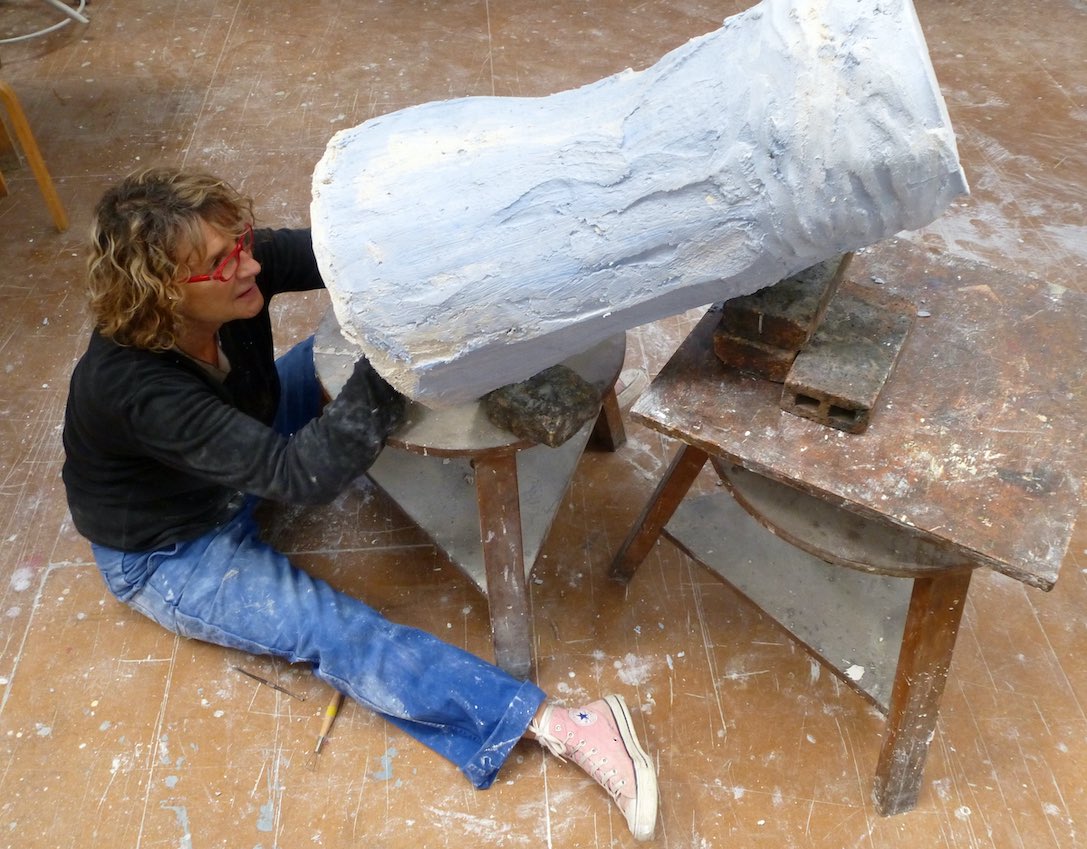
CV
CURRICULUM VITAE
Selected exhibitions
2025 Évasions passagères (sculptures), Nathalie Béreau Gallery, Espace Chapon, Paris
2024 Hors norme (installation and sculptures), Nathalie Béreau Gallery, Espace Chapon, Paris
Ramifications (sculptures), with Coco Téxèdre (drawings and paintings), Nathalie Béreau Gallery, Espace Chapon, Paris
Aragon-Triolet Cultural Centre, Orly
2023 Pas si bête, Espace Art et Liberté, Charenton-le-Pont
Claudine Legrand Gallery, Paris
2022 Solo exhibition, Espace Culturel, La Ferté-sous-Jouarre
2008, 2010, 2014, 2018, 2019, 2020, 2021, 2022, 2023 Galerie Nathalie Béreau
2018 Bonnefont Abbey
2015, 2016, 2017 The Véluze Gallery, Honfleur
2015, 2016, 2017 Glineur Gallery, Saint Martin de Ré
2008, 2011, 2013, 2016 Mac Paris (Contemporary Art Exhibition)
2014 Léhon Abbey, exhibition curator M.A. Lorillon, Dinan
2013 de Buci Gallery, Paris
2012 St Vincent Priory, coll. performance choreographer-dancer José Luis Sultan, Chartres
2011 ‘Nuit blanche’ with Voisimages, coll. N. Cadoret, sound materials, Paris
Château de Robersart, costume design, ‘African ballet at the court of King Louis XIV’
2010 Brissot Gallery, performance collaboration with choreographer-dancer José Luis Sultan, Paris
Claire Corcia Gallery, performance collaboration with choreographer-dancer José Luis Sultan, Paris
Selected exhibitions (continued)
2009 Christian Collin Gallery, “Estampes contemporaines”, curator N. Béreau, Paris
2008 Atelier D’Estienne, “L’art chemin faisant” (Art Along the Way), contemporary art trail, Pont-Scorff
Saint-Servais Abbey, ‘Les nuits blanches de Lucie’ (Lucie’s Sleepless Nights), coll. N. Cadoret creation of sound materials, Pont-Scorff
Marie Redor Gallery, Orléans
Brissot et Linz Gallery, Paris
Painting and collaboration with dancers
A long-standing dialogue with the dancer-performer José-Luis Sultan in the context of shows and regular workshop work. More than a classic painter/model approach, this dialogue is built around a meeting between two imaginary worlds that feed each other.
1998 Co-creation painting-contemporary dance, dialogue with the dancer José, Luis Sultan, Théâtre Les Amandiers, Paris
Edition
2003 “Agotem”, revue de littérature, éditions Obsidiane, n°1
2001 “Aleph Beth”, revue de littérature, n° 5, mars
Edition Aleph Beth, Nimrod, En majesté, le manteau rouge et noir du soleil
Journey-workshop
Since 2000 Creation of sculptures (lost wax bronzes) in Benin, during regular stays
Since 1994 Travel diary in Mali, Burkina-Faso, Benin
Price
2002 1st price of painting, Salon Mac 2000, Paris
artworks
Overview artworks
installations
The installations mix a diversity of materials – wire mesh, tarlatan, wood, crystal paste, bronze, wax, fresh grass… and bring together a plurality of fields – drawing/painting, volume/space, sound… They give place, in a punctual way, to collaboration with dancers/choreographers and musicians-sculptors of sound materials.
” La belle et la bête à l’entonnoir “. (Large female character, warthog, – both in painted wire mesh – funnel in tarlatan, photos …). This one questions, through the preponderant place of the funnel in the public and private space of the Beninese society, the modes of non-standardized consumption, modulable according to the needs of the individual as well as the mutations in progress.
“The path of needles”. (60 sewing needles of large format each in crystal paste, bronze, wood, presented in suspension). Their shadow is drawn on a large sheet of white paper. This proposal is visual but also sound, it is a musical instrument with crystalline sounds; the public is invited to play the needle with small felt sticks. The installation deals with the needle as a transversal symbol of various cultures. Carrier of narratives that are expressed in tales, songs, opera, word games, it builds bridges between continents.
With the needle, I try to sew the societies.
1. The Fall of the Rebel Angels, 2012, wire mesh, tarlatan, pigments, unique pieces. Variable size. (Photos Alberto Ricci / Marie Docher)
2/3. Beauty and the Funnel Beast, 2019, wire mesh, tarlatan, pigments, unique pieces.
4. The Path of the Needles, 2018-2024, bronze and glass paste, unique pieces. Variable size. Metal support structure or suspension.

